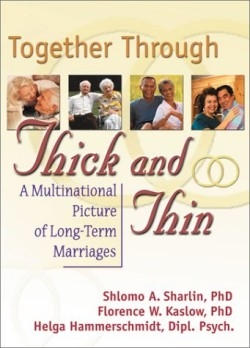Together Through Thick and Thin
A Multinational Picture of Long-Term Marriages
If Tolstoy were right and all happy families are alike, can the same be true about all happy marriages? The answer is a resounding “yes,” according to therapists Kaslow and Sharlin, who along with family researcher Hammerschmidt, conducted a study to determine what factors contribute to long and happy marriages. The results showed that couples who have been happily married for twenty years or more share “a cluster of characteristics” that transcend differences in cultures and countries. Couples list love, closeness, mutual trust, respect, responsibility, and a conviction that “marriage is a partnership for life” as ingredients for success.
Claiming to be “the largest multinational, multicultural study of long-term marriages conducted to date,” the book is geared toward family therapists and researchers. Its three parts present an overview of the study, the theoretical issues involved, and the methodology of the research. Data from questionnaires were collected from 575 couples from eight countries, including the United States, Sweden, Germany, Israel, Chile, South Africa, the Netherlands, and Canada. Results are combined and compared effectively in charts and lists, so readers may easily see how men and women within each country responded, as well as how they matched-up with participants from other countries.
Statistics are consistently summarized and analyzed in line with the book’s purpose: to provide other therapists with a “learning from success” profile by which to assist couples in knowing what methods have worked for those who’ve stayed together through “thick and thin.” While more than proving their hypothesis that “the ingredients for a long-lasting relationship are rather universal and are not bound by culture or geography,” the authors give only a few suggestions as to how this valuable information might be applied in a therapeutic setting. For instance, the study reveals that satisfied couples enjoy spending time together, so therapists are advised to suggest that couples plan more fun activities. More detailed information would have been welcome on how best to translate research results into practice or by laying out an actual working model for achieving more satisfying relationships based on the valuable conclusions reached.
Nevertheless, a book based on “positive functioning” is a step forward in turning around a therapeutic setting too often focused on the negative. It’s also refreshing to find authors who rise rhetorically to the level of their research. When couples listed “love” as the most frequently mentioned reason for the success of their marriage, nothing short of a simple metaphor out-powered all the weighty statistics: “Real depth of love is reached only through a relationship forged in the implacable kiln of time.” Tolstoy couldn’t have said it any better.
Reviewed by
Judy Hopkins
Disclosure: This article is not an endorsement, but a review. The publisher of this book provided free copies of the book to have their book reviewed by a professional reviewer. No fee was paid by the publisher for this review. Foreword Reviews only recommends books that we love. Foreword Magazine, Inc. is disclosing this in accordance with the Federal Trade Commission’s 16 CFR, Part 255.

